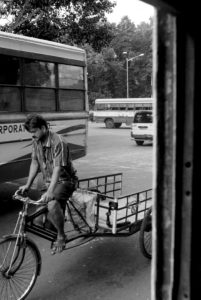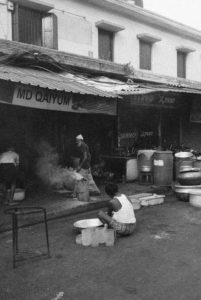By Isobel Chiang, 08/04/2019. If I’m being honest, the month before I left for India was not an enjoyable one: I was excited for my trip and elated about receiving the grant, of course, but mostly I was anxious and terrified, worried about small things like drowning in a monsoon, expiring in India’s summer heat, contracting dengue fever, getting bitten by a rabid dog and dying a slow, punishing death. It sounds theatrical — after being in India for the last month I now understand just how theatrical — but my head was/is filled with horror stories about travelling through India. In a New York Times article, one writer recounts his trip to Kolkata: “During a bout of amoebic dysentery,” he writes, “a British doctor told me I would ‘either die or get better.'”
But if I’m being really honest, what I was most anxious about was the actual research. This trip would mark my first time doing ethnographic research — heading out into the field, scouting sources, meeting with said sources, conducting interviews, transcribing interviews, collating research, etc, etc — all of which were to be done in a completely unfamiliar country.
I’m not saying I didn’t at least try to prepare for my field research: I spent half a year priming myself intellectually for this trip — reading as much as I possibly could about the Chinese diaspora, about the city of Kolkata, about the freaking history of India (I literally binged a PBS series called “The Story of India”).
But my preparedness could only get me so far; there was still so much I didn’t know. What if I can’t find any sources to interview? What if the sources I do find aren’t willing to share their stories with me? What if I get to Kolkata and Chinatown is in even worse shape that I imagined? What if I can’t even do my research because I’ve been bitten by A RABID DOG???
All of these what-ifs coalesced into a larger, more nihilistic question: what am I getting myself into?
I’ve been in India for about a month now. As a single, unaccompanied female, field research is both harder and easier than I imagined. (I should also note it’s a lot of fun.) I’ve learned so much about the process of putting myself out there, but mostly I’ve learned that conducting field research is like riding a bike: the only way to learn how to do it is by doing it.
I didn’t know anybody from the Indian Chinese community before I came to India. Luckily, the Chinese community in Kolkata has been exceptionally gracious and welcoming to me. Not only that, they have been forthcoming and candid in our interviews, which often last over three hours. On my first day, I walked into a business owned by an Indian Chinese family and started chatting with them. Within half an hour, we were sharing a meal in their home, located just above their store.
Having a personal connection to the community has definitely helped: they appreciate that “one of their own” has returned to the community, if only for a month. I often hear things like, “What was your dad’s name? Where did he live? Maybe I knew him.” Or, “I have a niece/brother/child/mother in Toronto! They always hang out at the mall in Markham — have you been?”
I’ve shared meals with Indian Chinese families, I’ve cooked with them, I’ve asked them questions both practical and personal: how many years have you been living in Territy? What is it that keeps you here, when all your family is in Toronto?
I’ve learned the importance of asking open-ended questions in interviews: instead of asking “what year were you born in,” I’ll ask, “tell me a little bit about your childhood.”
I’ve found that an entire interview can hinge on the way I word my questions: complicated questions yield short and truncated answers, but simple ones yield expansive, complicated responses. “What were the historical, political, and socio-economic factors that caused your family to emigrate from India to Canada?” — this will alienate and overwhelm my interviewee. But “What did it feel like to leave India?” — this will open them up. It’s the difference between getting an answer and getting a response.
But despite the fact that the Indian Chinese community has been so generous and hospitable, the process of collecting their oral histories has still been incredibly challenging. I started out asking questions that were too big, too abstract — questions about citizenship and immigration, about living as a minority in a country as big as India, about grappling with a complicated identity. Unsurprisingly, people had a hard time answering these questions, probably because they are impossible to answer. I wanted to learn about Chinese food within the diaspora through the prism of race, ethnicity, immigration, and transnationalism. But I was asking too much from my sources; my interviews were coming out flat and generic.
So I started asking more specific questions about Chinese food, and as a result, I elicited more evocative, rich, and detailed responses — all of which touched on themes of race, ethnicity, immigration, and transnationalism in an oblique but profound way. All I had to do was reverse the entire orientation of my
research approach.
Throughout this process, I’ve had to get over my fear of “imposing on people,” or my life-long paranoia of being a bother or a burden to anyone besides my parents. I’ve had to become adept at awkwardly asking people, cold turkey, if they’d be willing to take time out of their day to talk to a complete stranger.
There’s also the reality of conducting research in India during the summer, at the peak of monsoon season. The heat is truly punishing here. Honestly, a lot of interviewees will spend the first twenty minutes of the conversation talking about the heat, asking me if it’s this hot in Canada. Luckily the monsoons haven’t been too extreme, but today, for example, it’s simply too rainy to go outside.
The flash flooding, however, gives me a good excuse to stay inside and reflect on my field research thus far. I’ll be here for the rest of the afternoon, collating all my interviews and photographs — stumbling, rather clumsily, toward a better understanding of this formidable, frightening, fascinating country.


